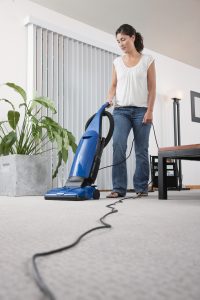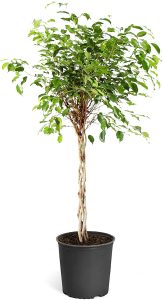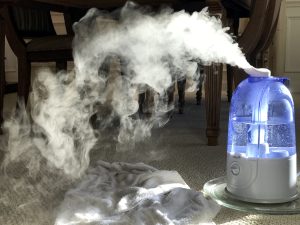By DEBORAH G. SCANLON
In the cold winter months, what could be more comforting than a roaring fire in the wood stove or fireplace? It keeps you warm and cozy and dries out those snow-covered mittens and boots.
 But with most of us spending about 90 percent of our time—or more—indoors in the winter, and the increased use of synthetic building materials, furnishings, personal-care products, pesticides and household cleaners in buildings that are far more energy efficient than in years past, we could be courting trouble.
But with most of us spending about 90 percent of our time—or more—indoors in the winter, and the increased use of synthetic building materials, furnishings, personal-care products, pesticides and household cleaners in buildings that are far more energy efficient than in years past, we could be courting trouble.
The federal Environmental Protection Agency warns that pollutants in our homes are “often two to five times higher than typical outdoor concentrations.”
For those of us who use, or even fully heat, our homes with wood, there can be problems associated with air quality in a house that is shut up tight. Dust from a smoky wood fire can cause respiratory problems, and it is just one issue that gets worse when there is no airflow. Here are some suggestions for improving the air in your home:
Keep your house dust free:
Obviously, keeping your house as clean as possible is critical.
First, a HEPA (high-efficiency particulate air) filter on your vacuum cleaner really makes a difference. It keeps the dust and dirt that you’ve just vacuumed up from being blown back out in the exhaust by forcing air through a fine mesh filter. You will immediately notice the improvement in removing the dirt and eliminating the dusty smell.
 There are two types of HEPA filters. The Wood Lumber Company has HEPA filters for shop vacs that are effective for cleaning up “general household stuff,” according to Greg Souza, hardware shop manager. He noted that a true HEPA filter used in a commercial unit is 99.97 percent effective, and that to remove asbestos and other toxic or hazardous dust, it is necessary to use this higher-grade HEPA filter and unit.
There are two types of HEPA filters. The Wood Lumber Company has HEPA filters for shop vacs that are effective for cleaning up “general household stuff,” according to Greg Souza, hardware shop manager. He noted that a true HEPA filter used in a commercial unit is 99.97 percent effective, and that to remove asbestos and other toxic or hazardous dust, it is necessary to use this higher-grade HEPA filter and unit.
That said, the HEPA filters that are available for household vacuum cleaners are very effective in removing larger particles, such as dust and dander.
The type of flooring you have may be a factor too. Harvard Health Publishing’s online newsletter suggests that hard-surface flooring instead of wall-to-wall carpeting may cut down on allergens in the home. And of course, the advice to clear clutter, since it “traps and holds dust that can trigger a reaction,” makes a lot of sense.
Dusting your furniture with microfiber dust cloths is recommended, because the dust is not released back into the air from the cloth.
Keep your wood stove efficient:
Keith Cliff, owner of Sandwich Chimney Sweep, Inc., is familiar with wintertime indoor air-quality issues. “Without air flowing through the house as it does in the summer with the windows open, the air can become very stagnant. No airflow decreases air quality. Also, if your fireplace or wood stove flue is dirty, it will not allow a good draft, leaving your home with smoke issues, odors and lack of airflow,” he said.
See Swept Up In The Season with Joe Bento on page 34
Improve air flow:
Mr. Cliff noted that today’s homes are “built much tighter than older, drafty houses,” creating a need for whole-house ventilation systems. These can be installed by HVAC [heating, ventilation and air-conditioning] companies and will allow for a cleaner air-quality environment, he said.
And on days when it is warm outdoors, try “natural ventilation”—one of the EPA’s website recommendations is to open windows and doors.
Air purifiers:
Air purifiers with HEPA filters are good for removing dust and irritants. There are purifiers that work through an HVAC system, and there are portable air purifiers. Check out the EPA Indoor Air Quality website (epa.gov) for a short consumer guide that provides information on portable air cleaners and on HVAC and furnace filters.
Pets and dander
Air purifiers are also recommended for the dander that our snuggly pets add to our household air. Harvard Health suggests regularly cleaning bedding, drapes and other items that tend to attract allergens; The American Academy of Allergy, Asthma & Immunology recommends washing them in water that is at least 130 degrees. They also suggest putting dust mite–proof covers on pillows, mattresses and box springs.
 Keep the humidity up:
Keep the humidity up:
Mr. Cliff suggests keeping a kettle of water on the wood stove; this will act as a humidifier and help control dust. Many of us who own wood stoves also have a humidifier in the bedroom. There are tabletop humidifiers—both warm mist and cool mist—which are good for small rooms, larger console models for bigger areas, and whole-house humidifiers. It is best to do some research to see which fits your needs.
Some practical actions: Leave the fan off in your bathroom when you shower, and let the steam out. And on days when you don’t hang clothes on the clothesline outside, use indoor racks, which adds some moisture to the air inside (and avoids using the energy-consuming dryer.)
Plants:
Do houseplants help with air quality? They do take in carbon dioxide and emit oxygen, but do they—as NASA concluded in a 1989 study—make a major contribution to purifying indoor air of such toxins as benzene and formaldehyde? That is up for discussion, because some people say plants grown in a laboratory for research with the optimal amount of light for photosynthesis cannot be compared with plants in your house. But whether the impact is major or minimal, just having plants in your house—especially in winter—is soothing and may reduce stress.
Terry Soares of Soares Nursery says many plants can flourish in the low light of winter in south-facing windows. She recommends cactus and other succulents, African violets, peace lilies, fiddle plants, and some of the larger plants, such as ficus and rubber trees. Just don’t overwater them, she cautions—let the plants get dry in the winter.

